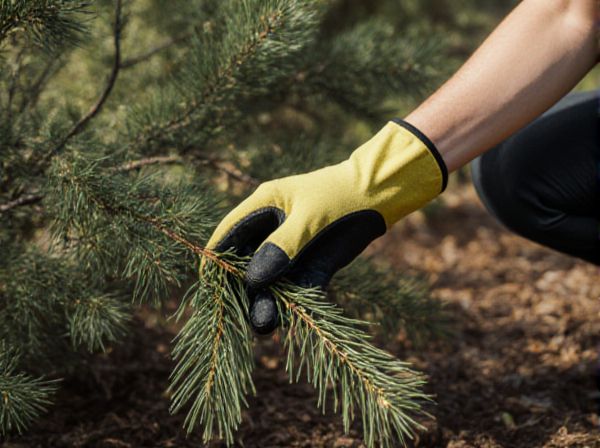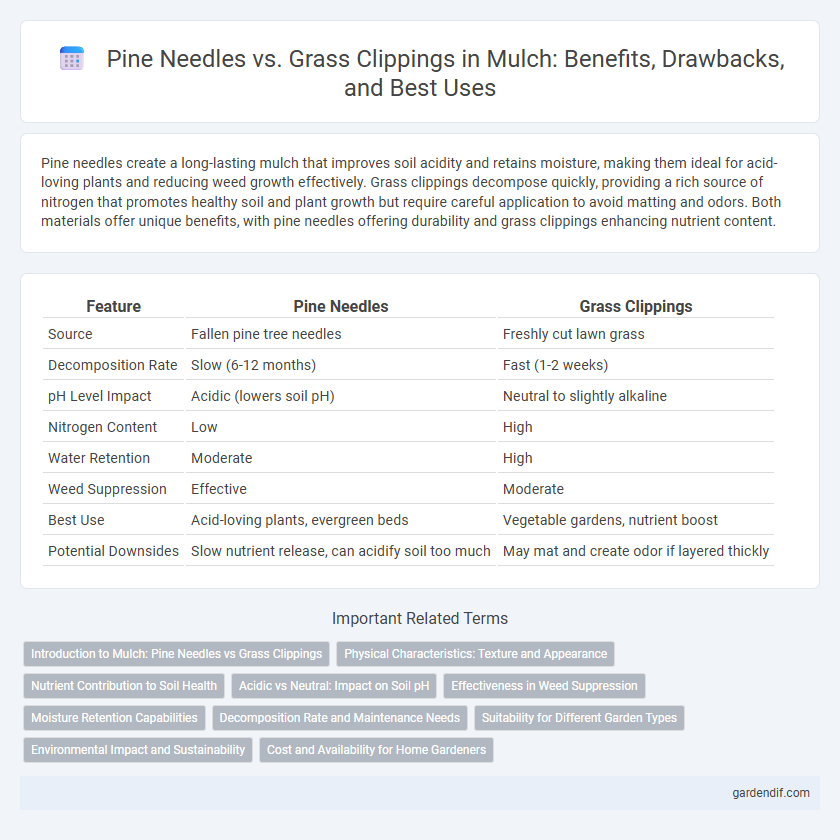
Pine needles vs Grass clippings Illustration
Pine needles create a long-lasting mulch that improves soil acidity and retains moisture, making them ideal for acid-loving plants and reducing weed growth effectively. Grass clippings decompose quickly, providing a rich source of nitrogen that promotes healthy soil and plant growth but require careful application to avoid matting and odors. Both materials offer unique benefits, with pine needles offering durability and grass clippings enhancing nutrient content.
Table of Comparison
| Feature | Pine Needles | Grass Clippings |
|---|---|---|
| Source | Fallen pine tree needles | Freshly cut lawn grass |
| Decomposition Rate | Slow (6-12 months) | Fast (1-2 weeks) |
| pH Level Impact | Acidic (lowers soil pH) | Neutral to slightly alkaline |
| Nitrogen Content | Low | High |
| Water Retention | Moderate | High |
| Weed Suppression | Effective | Moderate |
| Best Use | Acid-loving plants, evergreen beds | Vegetable gardens, nutrient boost |
| Potential Downsides | Slow nutrient release, can acidify soil too much | May mat and create odor if layered thickly |
Introduction to Mulch: Pine Needles vs Grass Clippings
Pine needles create a lightweight, acidic mulch ideal for acid-loving plants and improve soil aeration, while grass clippings offer a nitrogen-rich, quick-decomposing option that enhances soil fertility. Pine needle mulch resists compaction and conserves moisture longer, whereas grass clippings break down rapidly, releasing nutrients that stimulate plant growth. Choosing between pine needles and grass clippings depends on soil pH requirements, desired nutrient supply, and mulch decomposition rate.
Physical Characteristics: Texture and Appearance
Pine needles have a coarse, needle-like texture that creates an airy, lightweight mulch with a reddish-brown hue, enhancing garden aesthetics while allowing good air circulation. Grass clippings possess a finer, softer texture that forms a dense, green mulch layer, promoting rapid moisture retention and decomposition. The contrasting textures influence soil coverage quality and decomposition rates, affecting plant health and weed suppression.
Nutrient Contribution to Soil Health
Pine needles provide a slow-release source of nitrogen and lower soil pH, promoting acid-loving plants and improving soil structure over time. Grass clippings decompose rapidly, delivering an immediate boost of nitrogen, phosphorus, and potassium essential for vigorous plant growth. Both mulches enhance soil fertility but differ in nutrient availability speed and effects on soil acidity.
Acidic vs Neutral: Impact on Soil pH
Pine needles create acidic mulch, lowering soil pH and benefiting acid-loving plants such as azaleas and blueberries by enhancing nutrient availability. Grass clippings act as a neutral mulch, maintaining balanced soil pH and supporting a wider range of garden plants without significant pH alteration. Understanding the differing impacts on soil acidity helps gardeners choose mulch types that optimize nutrient uptake and plant health.
Effectiveness in Weed Suppression
Pine needles provide a natural, acidic mulch that effectively suppresses weeds by creating a dense, long-lasting barrier, while also allowing water penetration. Grass clippings decompose quickly, offering a nutrient-rich layer but require frequent replenishment to maintain adequate weed suppression. Consistently applying pine needles as mulch results in better long-term weed control compared to the more transient effect of grass clippings.
Moisture Retention Capabilities
Pine needles provide excellent moisture retention due to their natural waxy coating, which reduces evaporation and maintains soil hydration longer than grass clippings. Grass clippings decompose quickly, releasing nitrogen but tend to dry out faster, requiring more frequent reapplication to sustain soil moisture. Choosing pine needle mulch enhances water efficiency in garden beds, especially in drier climates or during hot summer months.
Decomposition Rate and Maintenance Needs
Pine needles decompose slowly due to their high lignin content, providing long-lasting mulch that requires minimal replenishment. Grass clippings break down rapidly, releasing nutrients into the soil quickly but necessitating frequent applications to maintain effective coverage. Choosing pine needles favors low-maintenance landscapes, while grass clippings suit gardeners seeking fast nutrient cycling and regular mulch renewal.
Suitability for Different Garden Types
Pine needles are ideal for acid-loving plants and woodland gardens due to their ability to slightly lower soil pH and improve drainage, making them perfect for azaleas, blueberries, and rhododendrons. Grass clippings suit vegetable gardens and flower beds as they decompose quickly, enriching the soil with nitrogen and organic matter that supports fast-growing plants. Choosing between pine needles and grass clippings depends on the garden's soil requirements and plant preferences to optimize growth and health.
Environmental Impact and Sustainability
Pine needles offer a slow decomposition rate, contributing to long-term soil health and minimizing waste accumulation, which enhances sustainability in mulching practices. Grass clippings decompose rapidly, enriching soil nutrients quickly but potentially leading to nitrogen runoff if overused, impacting local water systems. Using pine needles as mulch supports carbon sequestration and reduces the environmental footprint compared to frequent application of grass clippings.
Cost and Availability for Home Gardeners
Pine needles are often more affordable and readily available in regions with abundant pine trees, making them a cost-effective mulch option for home gardeners. Grass clippings, while generally free, require careful collection and drying to prevent mold and slime, impacting their immediate availability. Comparing cost and availability, pine needles offer consistent supply and ease of use, whereas grass clippings depend heavily on lawn maintenance schedules and storage conditions.
Pine needles vs Grass clippings Infographic

 gardendif.com
gardendif.com